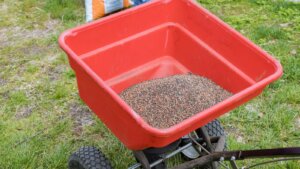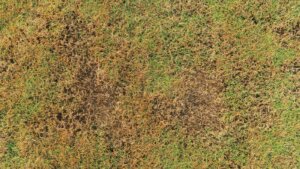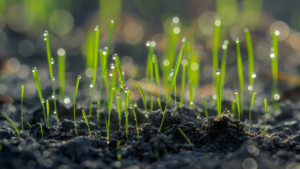Starting a new lawn or rejuvenating your existing turf in Collegeville, PA, requires meticulous lawn care practices. Knowing when to apply a starter fertilizer can make a significant difference in developing a thick, vibrant green space. Unlike regular fertilizers, starter fertilizers are designed for early germination and root development, providing a nutrient-rich environment essential for young grass seedlings.
Understanding Starter Fertilizer Composition
Starter Fertilizer for Grass Seed and Sod: Essential Nutrients
These fertilizers provide the right mix of nitrogen (N), phosphorus (P), and potassium (K) – key to a healthy start for your lawn. A balanced blend, such as a 10-10-10 NPK ratio, offers 10% of each crucial nutrient. Nitrogen spurs growth and color, phosphorus is vital for robust root systems, and potassium enhances disease resistance and drought resilience.
For optimal effectiveness, consider high-quality, complete fertilizers that contain both nitrogen and phosphorus are recommended (Penn State Extension). On soils already high in phosphorus, an N-only starter like ammonium sulfate or ammonium nitrate could be more suitable. Exercise caution with fertilizers high in diammonium phosphate and urea to prevent seedling injury.
Determining the Optimal Quantity of Starter Fertilizer for New Grass
How Much Starter Fertilizer Should You Apply for Vibrant Growth? Applying the right amount of starter fertilizer is crucial for the health of your new grass. Here’s a simple guide:
- Assess the Area: For every 1,000 square feet of lawn, the ideal amount is between 0.5 to 1 lb. of nitrogen.
- Moderation is Key: While using more is tempting, remember that using a starter fertilizer in excess can be detrimental to young grass, especially during overseeding.
- Use a Starter Fertilizer Specifically, Regular lawn fertilizers may not have the appropriate balance needed for planting new grass or overseeding.
Soil Testing: The First Step in Applying a Starter Fertilizer
Why is Testing Soil Critical Before Using Starter Fertilizer?
Understanding your soil’s current state is essential for successfully using starter fertilizers.
- Identify Nutrient Levels: Soil testing reveals crucial information about nitrogen, phosphorus, and potassium levels.
- Tailor Your Approach: Based on the test results, select a fertilizer that matches the nutrient balance needed, particularly for phosphorus, vital for new seed development. If your soil is high in phosphorus, opt for an N-only starter. Choose a fertilizer analysis that aligns with your soil test recommendations, especially if there’s a need for phosphorus or potassium (Penn State Extension).
- Avoid Guesswork: Soil testing eliminates guesswork, ensuring efficient and effective use of starter fertilizer.
Eco-Conscious Application of Starter Fertilizer for Lawn Health
Sustainable Practices in Using Starter Fertilizer for Lush Lawns Using starter fertilizer responsibly is not only beneficial for your lawn but also for the environment.
- Mind the Runoff: Be cautious in areas prone to runoff. Inappropriate use of fertilizers can lead to environmental issues.
- Phosphorus Awareness: If your soil test shows high phosphorus levels, reduce your use of phosphorus-based fertilizers or opt for phosphorus-free fertilizers.
- Eco-Friendly Alternatives: Consider using organic options like compost or biosolids. These alternatives are not only good for your lawn but also the planet.
When to Apply Starter Fertilizer: Timing for Grass Seedlings and Sod
Knowing when to apply a starter fertilizer is crucial for a healthy lawn. For grass seedlings, the best time is during sowing, integrating the lawn starter to aid in germination. In contrast, when laying sod, apply fertilizer beforehand to encourage root establishment. This targeted approach ensures that grass seedlings and sod receive the nutrients they need at the most beneficial time.
Seed and Sod Application Differences
Applying Starter Fertilizer to Grass Seed and Sod
For new grass seeds, integrate starter fertilizer during sowing to aid germination. Before laying sod, treat the soil with fertilizer to encourage root establishment.
The Bottom Line: Nurturing Your Dream Lawn
Cultivating a lush, verdant lawn in Collegeville, PA, is more than a chore—it’s an art. With the right approach to fertilization, particularly when establishing new grass or reviving your existing yard, you can cultivate a lawn that’s alive and thriving. Here’s a distilled essence of our comprehensive guide to ensure your green space receives the optimal care it deserves:
- Select the Appropriate Starter Fertilizer: Achieve balance with a 10-10-10 NPK ratio, recommended for uniform growth and robust seedling support.
- Apply the Correct Amount: Aim for 0.5 to 1 lb. of nitrogen per 1,000 square feet to nourish without damage.
- Conduct a Soil Test: This critical step will reveal the specific nutrients your lawn craves.
- Consider Environmental Impact: Choose environmentally friendly options if your soil test recommends against high-phosphorus fertilizers.
- Tailor to Seed or Sod: Whether seeding or sodding, apply fertilizer thoughtfully to support initial growth and root establishment.
Armed with this knowledge and a dedication to lawn excellence, you’re well on your way to fostering a lawn that’s pleasing to the eye and a testament to responsible stewardship.
Feeling overwhelmed? Or perhaps you’re eager to transform your lawn but unsure where to start? Allow the experts to guide you. Choose Terra Lawn Care Services and discover how our professional team can amplify the beauty and health of your lawn with precision and care. Whether it’s choosing the right time to water your lawn after fertilizing or determining the exact lawn needs for that lush growth, our lawn care services are tailored to ensure your green space in Collegeville, PA, is the envy of the neighborhood. Don’t just fertilize your lawn—elevate it with Terra Lawn Care today!



